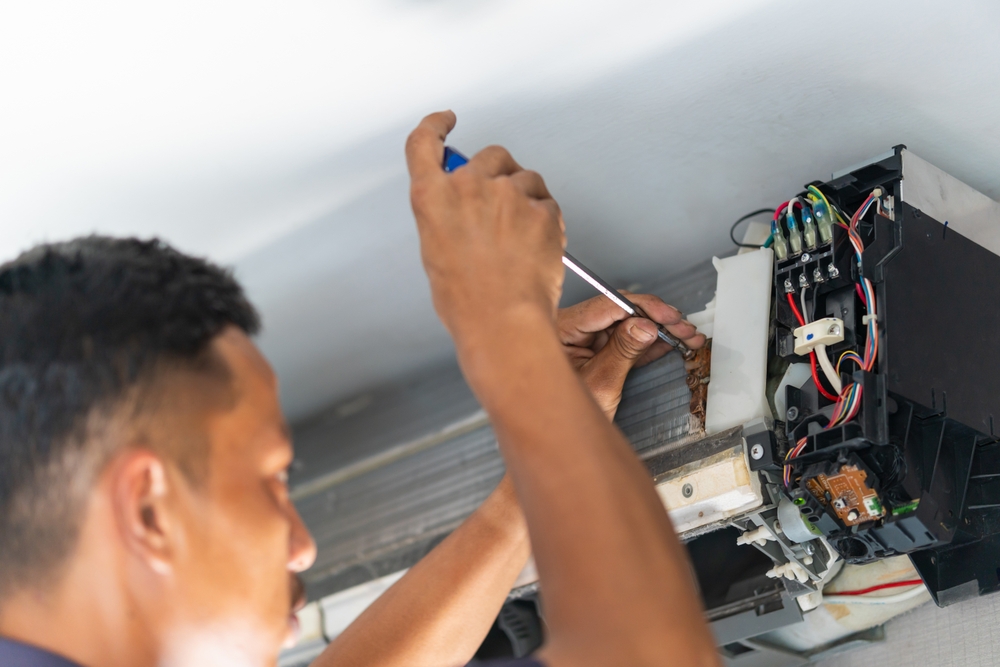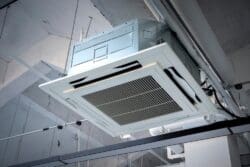
An air conditioner is more than just a machine that blows cool air; it’s an advanced system designed to extract heat and humidity from inside your home and push it outdoors, leaving behind a comfortable indoor environment. Whether you’re relaxing after work or trying to sleep through a summer night, your AC quietly works behind the scenes to keep your living space cool and breathable.
Understanding how air conditioners work can help homeowners troubleshoot common issues, schedule timely maintenance, and even improve energy efficiency. In this guide, we’ll break down the question of “How does AC cool air?”, explore the components involved, and show how professional care can extend the life of your system.
How Your AC Cools Your House
So, how does an AC cool air? At its core, an air conditioner removes heat from the air inside your home and transfers it outside. It does this using a closed-loop system that relies on refrigerant, a special fluid that changes between a gas and a liquid state to absorb and release heat. As the system circulates refrigerant, warm indoor air is drawn in, cooled down, and then pushed back through the vents.
This continuous cycle of extracting heat and replacing it with cooler air is what maintains your home’s steady, comfortable temperature throughout the day.
The Purpose of an Air Conditioner
The primary goal of an air conditioner is to regulate your indoor environment by removing heat and humidity. By drawing in warm, moist air, your AC system cools it using a process called heat exchange, then redistributes the cooled, drier air throughout the home via ducts or air handlers.
This not only keeps you comfortable but also improves your indoor air quality, reducing the presence of allergens, mold growth, and excess moisture that can lead to structural issues or discomfort.
Key Components of an Air Conditioning System
Every air conditioner relies on a few key parts that work in tandem to move heat out and bring cool air in. These components are split between indoor and outdoor units and function in a precise sequence to maintain efficiency and temperature control.
1) Evaporator Coil – The Heat Absorber
The answer to the question “How does AC cool air?” begins with the evaporator coil.
The evaporator coil is located inside your home, typically within the indoor air handler or furnace. As warm air from your rooms is drawn in through return vents, it passes over this coil, which contains cold refrigerant. The refrigerant absorbs the heat from the air, cooling it down before the air is blown back into your home.
Think of the evaporator coil like a sponge soaking up heat. It leaves the air cooler and drier while preparing the refrigerant for the next step in the cooling cycle.
2) Compressor – The Heart of the System
Once the refrigerant absorbs indoor heat, it travels outside to the compressor. This component is housed in the outdoor unit and serves as the “heart” of the AC system. Its job is to pressurize the refrigerant and move it through the rest of the cooling loop.
As the refrigerant is compressed, its temperature and pressure rise, preparing it to release the absorbed heat in the next phase. Without the compressor, the refrigerant couldn’t circulate or do its job effectively.
3) Condenser Coil – Releasing Heat Outside
The high-pressure, high-temperature refrigerant now flows into the condenser coil, also located in the outdoor unit. Here, a large fan blows outdoor air over the coil, allowing the refrigerant to release the heat it absorbed from inside your home.
This is the final step in eliminating unwanted heat. Once the refrigerant cools down and returns to a liquid state, it’s ready to start the cycle again inside the evaporator coil.
4) Expansion Valve – Regulating Refrigerant Flow
Before the refrigerant re-enters the evaporator coil, it passes through the expansion valve. This device reduces the pressure of the refrigerant, allowing it to cool significantly before it flows into the coil and begins absorbing heat once again.
By regulating the flow of refrigerant, the expansion valve ensures the system operates efficiently and consistently—delivering cool air to your home without overworking your equipment.

The Cooling Cycle Explained Step-by-Step
To better understand how an air conditioner works, let’s summarize the cooling cycle step by step:
- Warm air enters through return vents
Your AC system begins by pulling warm indoor air through return vents and into the air handler or furnace, where it’s directed toward the evaporator coil. - Heat is absorbed by the evaporator coil
The coil, filled with cold refrigerant, absorbs heat from the air. This causes the refrigerant to evaporate into a gas while the now-cooled air is pushed back through your vents. - The refrigerant travels to the compressor
The warm gaseous refrigerant is sent outdoors to the compressor, where it’s pressurized and its temperature is increased. - Heat is expelled by the condenser coil
The refrigerant flows through the condenser coil. As air blows over the coil, heat is released into the outdoor atmosphere, and the refrigerant condenses back into a liquid. - The cycle resets through the expansion valve
The cooled refrigerant passes through the expansion valve, drops in pressure, and heads back to the evaporator coil to repeat the process.
Think of the system like a sponge soaking up heat inside your home and then squeezing it out outdoors—repeating the process over and over to maintain your preferred temperature.
How Different Types of Air Conditioners Work
Air conditioners come in different forms to suit various building sizes, layouts, and energy efficiency needs. This raises the question, “How do AC units work?” when considering the various styles available.
Here’s a breakdown of how the most common types of AC systems operate:
Central Air Conditioning
Central AC systems use a split or packaged setup with an indoor evaporator coil and an outdoor condenser/compressor. These units are connected through ductwork that distributes cooled air throughout the home.
Split systems are more common in modern homes, while packaged units house all components in a single outdoor cabinet. Each option is ideal for cooling large spaces consistently and efficiently.
Ductless Mini-Splits
Ductless systems, or mini-splits, consist of one outdoor compressor and one or more indoor air handlers. Each air handler serves an individual room or zone, allowing you to control temperatures independently.
This zoned cooling approach is perfect for home additions, apartments, or rooms without ductwork. Plus, they’re typically more energy-efficient and quieter than traditional systems.
Window Units and Portable ACs
Window and portable air conditioners are self-contained systems, ideal for use in single rooms. These units draw in warm air, cool it using internal evaporator coils, and then expel the heat through a vent or exhaust hose.
While cost-effective, they’re generally less efficient, louder, and offer limited humidity control compared to whole-home systems.
Hybrid and Smart Systems
Hybrid systems combine gas and electric power to optimize energy usage depending on the outdoor temperature. Smart ACs or systems paired with smart thermostats can adjust cooling remotely based on personalized schedules, occupancy, or even your location.
The Role of Refrigerant in Heat Exchange
Refrigerant is the lifeblood of your air conditioning system. As it cycles through the AC loop, it constantly shifts between liquid and gas. In its cold, low-pressure liquid form, refrigerant absorbs heat from indoor air. Then, as a hot, high-pressure gas, it releases that heat outdoors.
This phase-change process is what enables the transfer of heat in and out of your home. If refrigerant levels are too low, often due to a leak or system inefficiency, the entire cooling cycle breaks down. You may notice warmer air blowing from vents, ice forming on coils, or rising energy bills. If you suspect an issue, it’s essential to call an HVAC professional for inspection and recharging.
How AC Systems Handle Humidity
Air conditioning doesn’t just cool your home; it also plays a significant role in controlling indoor humidity. When warm air is drawn across the evaporator coil, the coil not only removes heat from the air but also pulls moisture from it. That moisture condenses into water droplets and drains away through the system’s condensate line.
Excess humidity can make 75°F feel like 85°F, so this dehumidification process makes your home feel cooler and more comfortable—even if the temperature isn’t drastically lowered.
A well-functioning AC system helps prevent mold growth, condensation on windows, and that clammy, sticky feeling indoors, all while supporting better indoor air quality.
Keep Your AC in Top Shape With Seasonal Tune-Ups
Like any hardworking system, your air conditioner needs regular maintenance to stay in peak condition, and Gulfshore Cooling, LLC is proud to offer high-quality AC tune-up and repair services throughout Southwest Florida.
Our seasonal tune-ups include:
- Checking and cleaning the evaporator and condenser coils
- Inspecting electrical components and tightening connections
- Testing refrigerant levels and recharging if needed
- Cleaning or replacing air filters
- Measuring airflow and checking thermostat accuracy
- Inspecting the condensate drain and clearing blockages
These proactive measures help prevent common issues like poor cooling performance, warm air blowing from vents, high energy bills, or sudden breakdowns. By scheduling routine maintenance, you not only extend the life of your AC unit but also avoid costly repairs and improve long-term efficiency.
Our licensed technicians are trained to spot early signs of wear, detect potential refrigerant leaks, and provide expert recommendations tailored to your system and usage habits. When you work with our experienced team, you’ll enjoy peace of mind knowing your comfort is in capable hands.
Get Expert Help with Your Air Conditioning Needs
Whether you’re upgrading your cooling system, need help diagnosing an issue, or just want to schedule a seasonal tune-up, Gulfshore Cooling, LLC is your trusted partner in indoor comfort. With decades of experience and a reputation for prompt, professional service, our team helps homeowners throughout Fort Myers and the surrounding areas maximize the performance of their HVAC systems.
Now that we’ve answered the question, “How does AC cool air?”, we’re here to optimize your air conditioner’s performance. We offer:
- AC installation for new construction and replacements
- Fast diagnostic services and system troubleshooting
- Personalized cooling solutions tailored to your home
- Honest recommendations from a team that puts your comfort first
If your current unit is aging, inefficient, or struggling to keep up, we’re here to help. We’ll walk you through your options and deliver solutions designed for performance, efficiency, and peace of mind. Don’t wait until the next heatwave hits—contact us today to schedule your next AC service.



